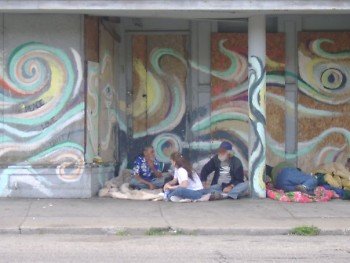
This is a picture of the alcove store front of 217 S. Division. This pictrue was taken about a year before Mr. Erkfitz created t /Courtesy of Erwin Erkfitz

This is a picture of the alcove store front of 217 S. Division. This pictrue was taken about a year before Mr. Erkfitz created t /Courtesy of Erwin Erkfitz
It is funny how one small change in the urban ecosystem can create major positive improvements in a neighborhood. One of these small changes is the mural created by Erwin Erkfitz at 217 S. Division. This building is typical of the turn-of-the-century design in that it boasts an alcove in its front entrance. In the last ten years, the alcove had become the home of substance abusing vagabonds. These individuals would use the space for sleeping, eating, public substance abuse and public fornication. Passerbys enjoying the sights down on the Avenue for the Arts would be greeted by intimidating belligerent comments as they passed by the space at 217 S. Division. The individuals in this space would be so inebriated that as you gazed upon them, they would resemble zombie-like creatures hiding in the darkness. These individuals had been urinating so frequently on the building entrance—made of wood—that it had begun to rot. This was a major eyesore for the Heartside neighborhood. Many attempts were made by the Grand Rapids police and the members of the Heartside neighborhood to relocate these individuals to the local missions.
This major problem existed because local missions, Guiding Light and Mel Trotter Ministries, will not accept people after curfew or who are under the influence of a harmful substance. Since the individuals who inhabited the alcove had major substance abuse problems, they would not get in. The alcove could not be guarded 24 hours a day, so they often ended up there sooner or later.
Attempts from the neighborhood to control the problem had all but ended when Mr. Erkfitz made a deal with the owner of the building, Kevin Haviland, to use the building to create his Artprize entry. Mr. Erkfitz nailed boards over the alcove to create a large canvas. After he finished his mural, which starts at 217 and goes all the way to the side of 219 S. Division, He placed a row of large florescent lights above the mural. Mr. Erfitz took a few condemned buildings and turned them into a work of art. He also made an area of the street that used to be dark and foreboding and turned it into a well-lit, vagabond-free spot.
The Heartside neighborhood has been a registered historic district since the late '70s. Due to this, the beautiful buildings were not turned into parking lots during the “modernization movement” that destroyed a lot of our downtown area. Since Mr. Erkfitz had changed the outside appearance of the building, Mr. Haviland was in violation of code.
On November 4, 2009 the Historic Preservation Commission held a meeting to decide the fate of the mural. A few organizations and many organizations, including myself, came out to support the mural. One of the organizations was the Grand Rapids Police Department. Letters and emails were also sent out to the Historic Preservation Commission. It was decided that the mural shall remain up for a period of one year or till the building is rehabbed, whatever happens first. This decision will be a major help to the neighborhood.
The main concern now is what if a year passes and the building isn’t rehabbed? We will have to cross that bridge when we come to it. This story is not over; it has just begun, but for now, Mr. Erkfitz’s actions have made the neighborhood a safer place.
The Rapidian, a program of the 501(c)3 nonprofit Community Media Center, relies on the community’s support to help cover the cost of training reporters and publishing content.
We need your help.
If each of our readers and content creators who values this community platform help support its creation and maintenance, The Rapidian can continue to educate and facilitate a conversation around issues for years to come.
Please support The Rapidian and make a contribution today.